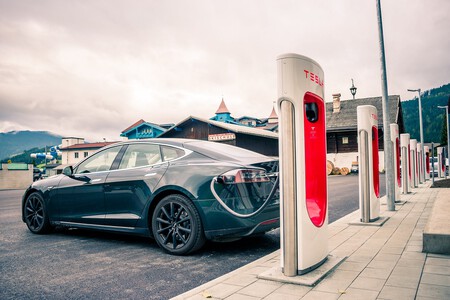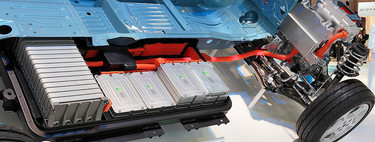Your electric car ready in three minutes: China believes that the future lies in the exchange of batteries

With electric vehicle technology settling in, how to charge the batteries remains one of the key points when making the leap to buying a new car. Needing a recharging point at home or at work, planning a trip well or anticipating a long stop along the way to recover sufficient autonomy continues to cause reluctance. A barrier to entry that the exchange of batteries wants to solve.
Ever since the electric car began to gain popularity, battery swapping has always had its supporters. The system is simple: go with the car to a charging station where some machines remove the battery from it and replace it for a fully charged one. The driver can continue on his way in a few minutes and the removed battery is serviced at the station.
This infrastructure is also being used with some electric motorcycles, where the size of the batteries allows for easier battery management. In cars it involves more problems, although its use is growing in China and was already tested by Elon Musk or Renault in its early days.
Battery swapping is not new but seems to be working now
As we told you, the use of a charging network with battery exchange for electric cars is not new. During his early years, Tesla offered this service in the United States, but the project was a failure in part due to the very services that the brand already offered. And it is that the superchargers at that time were free, while the exchange of batteries was paid. Plugging in the car and continuing to drive for free was too tempting, even if longer waiting times were needed.
At the end of 2011, Renault presented its Fluence Z.E, an electric sedan whose limited autonomy was limited to between 80 and 200 kilometers. If we add to this that the batteries were mostly in the trunk, leaving it almost unusable, we found ourselves before a car designed to travel, which could barely cover more than a hundred kilometers on a single charge and was too big for the daily urban environment.
One of the solutions was to set up a battery replacement infrastructure. To do this, Renault partnered with Better Place, which in Denmark and Israel had facilities where Fluence ZE batteries were changed in a few minutes and where they believed they could put a total of 100,000 electric vehicles on the road. At the end, the company went bankrupt after selling 1,000 units in Israel and 240 in Denmark.
But, as may have happened with the Twizy, it’s possible that Renault got to the battery-swapping system early. A decade later, in China they are taking it seriously and it seems that the pilot projects are going ahead. The main reasons are related to the price of vehicles and Chinese demographics.
China welcomes battery swap
The benefits to the driver in swapping electric car batteries are obvious. To the replacement times, which the Chinese manufacturer Nio claims to have reduced to three minutes, we must add the cost reduction for the buyer of the electric car.
“Battery swapping is indeed much faster than charging, almost like adding oil.”
Charging an electric vehicle can take hours but China’s NIO is cutting it down to minutes with battery swapping technology @NIOGlobal.
More: https://t.co/bdq0VFYWKM pic.twitter.com/aHBWcgA09B
— Bloomberg Quicktake (@Quicktake) December 2, 2020
With this system, the buyer buys the car but rents the battery. Energy storage is the most expensive element to produce in the electric car. If your price is taken out of the equation, the buyer will see the price cut and, even if they have to pay a periodic amount for rent, the battery degradation it will be less noticeable than if you owned one for years.
Both Nio and Geely are especially interested in your battery swap projects. In fact, Geely says that by 2025 it plans to have 5,000 stations of this type in operation. For now, the Chinese government has launched a pilot project with 1,000 stations available in eight cities, with three of them dedicated to the electric truck. Total, Bloomberg He assures that, with the sum of all the Chinese companies that have similar projects, in 2025 there should be 26,000 battery exchange stations in China.
These stations are highly attractive in China, where electric car sales are exploding (one in five vehicles sold is fully electric) and most of the population lives in apartments of buildings, with the impossibility of opting for the benefits of a domestic recharge of single-family homes.
And to the previous benefits we must add the interesting recycling solution that opens with the exchange of batteries. The permanent rotation of the same allows a more exhaustive control of their useful life, the detection of failures and derive them to other sectors when they are not useful for automobiles, as they do in Contemporary Amperex Technology Co (CATL), one of the world’s largest battery manufacturers.
The great stumbling block: agree
In theory, the benefits to drivers are clear, but there are two major barriers to entry to get the system up and running. The first is the large investment that must be made. It is estimated that a battery exchange station cost 10 times more than a space with recharging points. A very high investment for a project that has yet to be seen if it has a future.
And the second, and more important, is that these infrastructures have to agree with manufacturers to standardize batteries and structural constructions in vehicles.

The standardization of batteries and their position in the chassis means that manufacturers could not offer one of their current biggest attractions: better autonomies and better recharging times than the competition. Ending that added value in an expanding market does not seem to be well received by manufacturers now that they are looking to stay ahead of the competition.

It must be taken into account that, in addition to the vehicle, the future of the manufacturers lies in continuing to manufacture their own batteries and establishing their own recharging points. This happens to Tesla, whose autonomy and autonomous supercharger network is presented as one of the differentiating values in the purchase. In fact, Elon Musk’s firm is already carrying out tests to load vehicles from other brands and open a new line of business for the company.
Photos | CATL and Jacob Harder
Reference-www.xataka.com